Artículos SCI
2018
2018
Nanotecnología en Superficies y Plasma
Influence of irrigation conditions in the germination of plasma treated Nasturtium seeds
Molina, R; Lopez-Santos, C; Gomez-Ramirez, A; Vilchez, A; Espinos, JP; Gonzalez-Elipe, ARScientific Reports, 8 (2018) art. 16442
Show abstract ▽
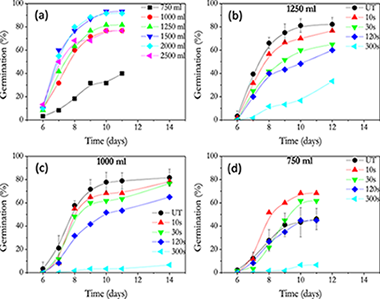
Plasma treatments had emerged as a useful technique to improve seed germination. In this work we investigate the influence of different irrigation conditions and plasma treatments on the germination of nasturtium seeds. During plasma treatment, seeds experience a progressive weight loss as a function of treatment time that has been associated to water release, a process that is more pronounced after longer plasma treatment times. Seeds treated for short times (<30 s) are able to germinate more efficiently than untreated specimen under hydric stress (drought conditions), while plasma treatments for longer times (up to 300 s) impaired germination independently on irrigation conditions. Characterization analysis of plasma treated seeds by FTIR-ATR, SEM/EDX and XPS showed that plasma treatment affected the chemical state of pericarp while, simultaneously, induced a considerable increase in the seeds water uptake capacity. The decrease in germination efficiency found after plasma treatment for long times, or for short times under optimum irrigation conditions, has been attributed to that the excess of water accumulated in the pericarp hampers the diffusion up to the embryo of other agents like oxygen which are deemed essential for germination.
Noviembre, 2018 | DOI: 10.1038/s41598-018-34801-0
Reactividad de Sólidos
Scalable synthesis of potential solar cell absorber Cu2SnS3 (CTS) from nanoprecursors
Hegedus, M; Balaz, M; Tesinsky, M; Sayagues, MJ; Siffalovic, P; Krulakova, M; Kanuchova, M; Briancin, J; Fabian, M; Balaz, PJournal of Alloys and Compounds, 768 (2018) 1006-1015
Show abstract ▽
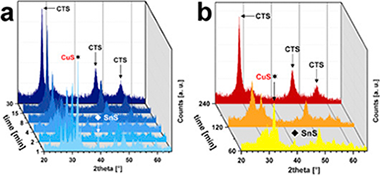
The present paper demonstrates an easy and scalable mechanochemical synthesis of ternary sulfide Cu2SnS3 (CTS) as a promising solar cell absorber. For the synthesis, pre-milled nanoparticles of CuS and SnS were used. The pure CTS phase was readily obtained after 60 min of milling in a laboratory planetary ball mill and 240 min in an industrial eccentric vibration industrial mill, respectively. The reaction progress of laboratory scale synthesis was studied by the quantitative Rietveld analysis. The reaction speed reaches its maximum at 4.6 min and the reaction is completed at approximately 60 min, according to the fitted data. The products of the syntheses were further characterized by X-ray powder diffractometry, Raman spectroscopy, scanning electron microscopy, X-ray photoelectron spectroscopy and UV-Vis spectroscopy. The results revealed formation of near-stoichiometric CTS nanoparticles with tetragonal I-42m symmetry. An average crystallites size of approximately 10-15 nm was determined for CTS phase. The SEM images support quintessential polydisperse character of the powders obtained by ball-milling approach. The materials seem to be suitable for photovoltaic applications with the band-gap energies of approximately 1.16-1.19 eV.
Noviembre, 2018 | DOI: 10.1016/j.jallcom.2018.07.284
Materiales Ópticos Multifuncionales
High voltage vacuum-deposited CH3NH3PbI3–CH3NH3PbI3 tandem solar cells
Avila, J; Momblona, C; Boix, P; Sessolo, M; Anaya, M; Lozano, G; Vandewal, K; Miguez, H; Bolink, HJEnergy & Environmental Science, 11 (2018) 3292-3297
Show abstract ▽
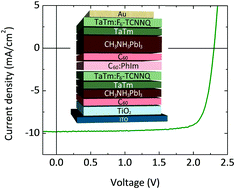
The recent success of perovskite solar cells is based on two solid pillars: the rapid progress of their power conversion efficiency and their flexibility in terms of optoelectrical properties and processing methods. That versatility makes these devices ideal candidates for multi-junction photovoltaics. We report an optically optimized double junction CH3NH3PbI3-CH3NH3PbI3 tandem solar cell where the matched short-circuit current is maximized while parasitic absorption is minimized. The use of an additive vacuum-deposition protocol allows us to reproduce calculated stack designs, which comprise several charge selective materials that ensure appropriate band alignment and charge recombination. This rationalized configuration yields an unprecedented open circuit voltage of 2.30 V. Furthermore, this tandem solar cell features efficiencies larger than 18%, higher than those of the individual sub-cells. Low photo-current values allow reducing the losses associated to the series resistance of transparent contacts, which opens the door to the realization of efficient large area modules.
Noviembre, 2018 | DOI: 10.1039/c8ee01936c
Reactividad de Sólidos
Mechanically induced combustion synthesis of niobium carbonitride nanoparticles
Jalaly, M; Gotor, FJ; Sayagues, MJJournal of Solid State Chemistry, 267 (2018) 106-112
Show abstract ▽
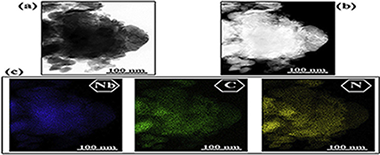
Niobium carbonitride [Nb(C,N)] nanoparticles were synthesized by a combustive mechanochemical reaction in the Mg/Nb2O5/C3H6N6 system. High-energy ball milling was used to promote a mechanically induced self-sustaining reaction (MSR). Combustion occurred after a very short milling period of 5 min. X-ray diffraction (XRD), X-ray photoelectron spectroscopy (XPS), energy-dispersive X-ray spectroscopy (EDS) and electron energy loss spectroscopy (EELS) analyses revealed that the nature of the product is an intermixed carbonitride material. The formation mechanism of Nb(C,N) resulted from the magnesiothermic reduction of niobium oxide to generate elemental Nb, which then reacted with the species generated from the melamine decomposition.
Noviembre, 2018 | DOI: 10.1016/j.jssc.2018.08.027
Química de Superficies y Catálisis
Analysis of the variables that modify the robustness of Ti-SiO2 catalysts for alkene epoxidation: Role of silylation, deactivation and potential solutions
Plata, JJ; Pacheco, LC; Remesal, ER; Masa, MO; Vega, L; Marquez, AM; Odriozola, JA; Sanz, JFMolecular Catalysis, 459 (2018) 55-60
Show abstract ▽
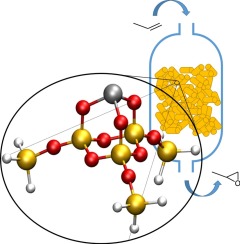
Catalytic epoxidation of alkenes plays an essential role in the transformation and synthesis of many organic chemicals. Ti atoms grafted on mesoporous silica, silylated on the surface, is considered the most active and selective catalyst for these reactions. However, the durability and robustness of the active centers remain as the main drawback in industry. In this paper, the characterization of industrial samples is combined with DFT calculations to rationalize the deactivation process of the catalyst and improve its performance. Silylating agents are characterized by experimental and simulated 29Si-NMR and their role in the catalytic mechanism is analysed. Potential deactivation processes are identified before, during and after the reaction. Modifications of the silylating agents and of the active center are proposed to improve the durability of the catalyst.
Noviembre, 2018 | DOI: 10.1016/j.mcat.2018.08.010
- ‹ anterior
- 150 of 420
- siguiente ›














